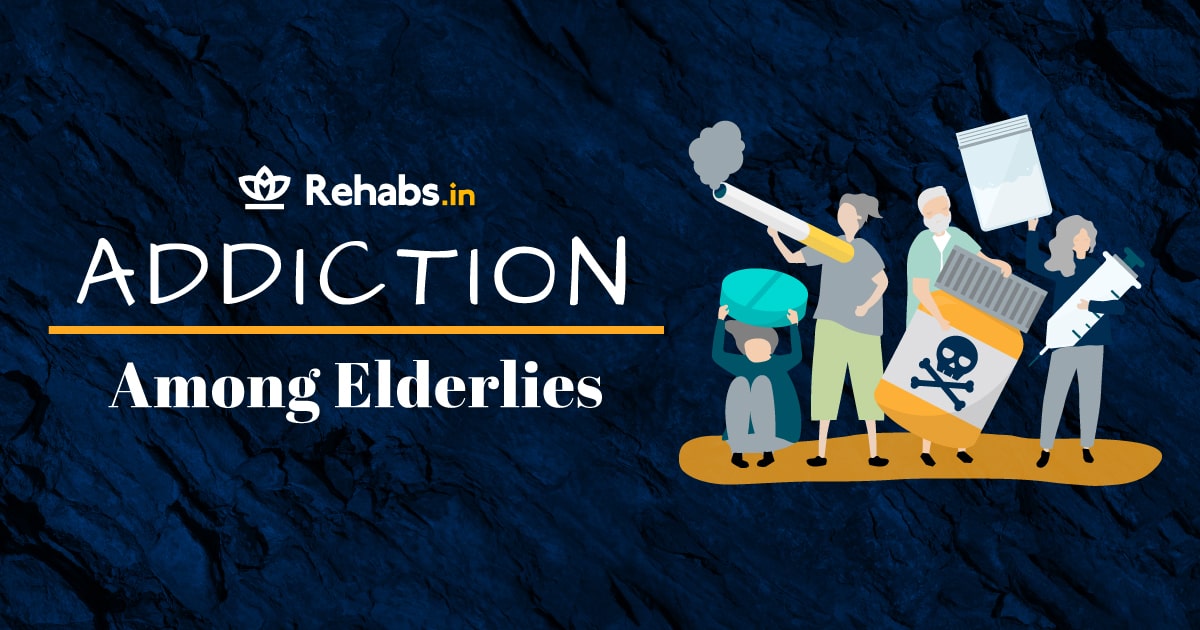The Issue Of Addiction Among Elderlies

When we think about old people, we often think about our grandparents. More often than not, those memories consist of warm hugs, story-telling sessions, delicious food and visits to native places. However, there is a small but significant population of old people that is quite cut off from this ideal scenario.
The slowing of the death rate along with an increase in longevity has led to a rise in the elderly population, the world over. India being one of the most populated countries in the world, will naturally also have a high percentage of the elderly population.
It is hard to imagine old people having substance abuse problems. However, it does exist. There are a few who have been addicts their whole life but there are also cases who have recently started abusing drugs due to psychological, physical and social issues around them.
Psychological, Physical And Social Problems Faced By Elderlies
In India, the elderly are treated with respect. Most of us take care of our elderly parents with tender love and care. However, there are also many elderly Indians that are left to fend for themselves.
There is a growing population of old people who live alone. Either their kids have abandoned them or have left the country leaving them behind. There are also those who have been turned out of their own homes by their children or relatives and left on the streets to fend for themselves. The loss of a spouse/child is also a major cause of loneliness among old people.
With retirement, there is a loss of not just income and economic stability, but also social proximity to colleagues who may have been cherished friends. The death of friends and relatives who are old keep reminding them of their own impending deaths. This new phase of life can be isolating and at times frightening.
The onset of old age also brings physical problems, like slow mobility, hearing and eyesight problems, body aches and pains and various other medical problems. The young family members may view the elderly in their family as burdensome because of all the care they require. All of these may lead to depression and in some cases may lead to substance abuse problems among the elderly.
Types of Substance Abuse Among The Elderly
The type of drugs abused by elders often differs from those abused by the youth. Cannabis, Heroin, LSD and other psychotropic and hallucinogen drugs are often abused by the younger population. The elderly on the other hand abuse alcohol, tobacco, prescription drugs and in some cases opioids. The choice of these drugs could be based on the fact that alcohol, tobacco and prescription drugs are legal and easily available.
Alcohol addiction: While there needs to be more research and studies on substance abuse among the elderly there are a few reports that suggest that alcohol is the most preferred drug. An epidemiological study by Sethi and Trivedi reported alcohol abuse of 11.3% in the 55-64 years age group and 16.8% in the 65-74 years age group. Interestingly, there are a greater number of elderly alcohol abusers in urban areas than in rural areas. There are also a few studies that have reported prevalence estimates for alcohol abuse among Indian elderly women, which range from 0% to 11.6%.
Tobacco addiction: The abuse of tobacco, both in the form of smoking and chewing is highly prevalent among the elderly. A study conducted by Mundada et al. among the rural population of Aurangabad in Central Maharashtra, reported addiction problems in 68.34% of elderly males of which addiction to smoking was at 29.96%, and addiction to tobacco chewing was at 29.29%. Among the elderly females, 45.42% of elderly females chewed tobacco. A study conducted in North India by Davey et al (2016) showed that the frequency of tobacco usage among the elderly was 56.7%, with smoking being the dominant one at 37% and the majority of it being in the form of Bidi (small hand-rolled cigarettes made of tobacco and wrapped in a tendu or temburni leaf; popular among low-income groups throughout South Asia and parts of the Middle East) at 56.7%.
Opioids and other drugs: A more current nationwide survey about the use of psychoactive substances reported that 30% of the abusers were in the middle years of their life and elderly. A study conducted on 63 subjects aged 60 years and above who were seeking treatment at a drug de-addiction centre in Chandigarh reported that alcohol was the most commonly abused substance (60%) followed by opioids (35%).
The Way Forward
Most old people often don’t realise that they have a substance abuse problem and hence they do not actively seek treatment. Even their physicians may misdiagnose them for having severe depression or anxiety. There needs to be more awareness about this issue which can be shared by family practitioners with their patients and their families. Elderly people need to be treated with the love and respect that they deserve. Family members need to be more vigilant and see to it that the problems faced by their elders do not lead to addiction.
The attitude that elderly people are at the end stage of their life and should be allowed to indulge in vices like alcohol, tobacco and other drugs, to ease their suffering is wrong. Old age doesn’t mean imminent death and hence health and happiness should be pursued with the same vigour as of the youth. The sunset years should not be darkened by addiction but should shine with the golden hue of comfort, joy and serenity.
Sources
https://www.researchgate.net/publication/290994911_Substance_use_disorders_in_the_elderly_A_review
https://www.who.int/ageing/projects/elder_abuse/alc_ea_ind.pdf?ua=1
https://www.researchgate.net/publication/290994911_Substance_use_disorders_in_the_elderly_A_review
Sethi BB, Trivedi JK. Drug abuse in the rural population. Indian J Psychiatry 1979;21:211-6.
Gupta R, Sharma S, Gupta VP, Gupta KD. Smoking and alcohol intake in a rural Indian population and correlation with hypertension and coronary heart disease prevalence. J Assoc Physicians India 1995;43:253-8.
Gupta R, Sharma S, Gupta VP, Gupta KD. Smoking and alcohol intake in a rural Indian population and correlation with hypertension and coronary heart disease prevalence. J Assoc Physicians India 1995;43:253-8.
Nadkarni A, Murthy P, Crome IB, Rao R. Alcohol use and alcohol-use disorders among older adults in India: A literature review. Aging Ment Health 2013;17:979-91.
Srinivasan K, Vaz M, Thomas T. Prevalence of health related disability among community dwelling urban elderly from middle socioeconomic strata in Bangaluru, India. Indian J Med Res 2010; 131:515-21
Jotheeswaran AT, Williams JD, Prince MJ. Predictors of mortality among elderly people living in a south Indian urban community; a 10/66 Dementia Research Group prospective population-based cohort study. BMC Public Health 2010;10:366.
Vedantam A, Subramanian V, Rao NV, John KR. Malnutrition in free-living elderly in rural south India: Prevalence and risk factors. Public Health Nutr 2010;13:1328-32.
Ray R. The extent, pattern and trends of drug abuse in India: National survey. New Delhi: Ministry of Social Justice and Empowerment, Government of India and United Nations Office on Drugs and Crime, Regional Office for South Asia.; 2004.
Grover S, Irpati AS, Saluja BS, Basu D, Mattoo SK. Drug dependence in the geriatric age group: A clinic-based study. Ger J Psychiatry 2008;11:10-5.
Mundada V, Jadhav V, Gaikwad AV (2013) Study of addiction problems and morbidity among geriatric population in rural area of Aurangabad district. Journal of Mid-Life Health 4(3): 172-175.
Davey S, Singh JV, Raghav SK, Muzammil K, Shankar R (2016) Tobacco use and its impact on pulmonary health among elderly population in rural area of Muzaffarnagar – A cross-sectional study. Indian J Tuberc63(3): 183-191














